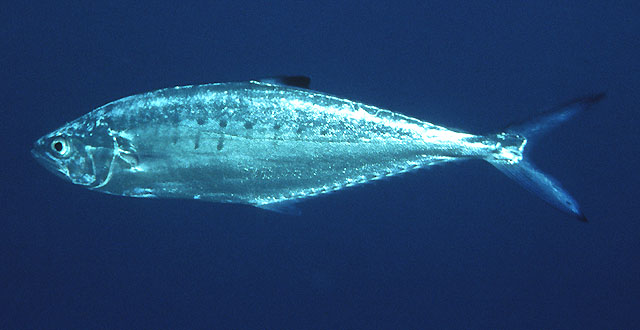| Carangidae (Jacks and pompanos), subfamily: Scomberoidinae |
| 110 cm TL (male/unsexed); max.weight: 11 kg |
|
reef-associated; brackish; marine; depth range 0 - 100 m |
| Indo-Pacific: Red Sea and East Africa to Hawaii, Marquesas, Line and Tuamoto islands, north to southern Japan, south to New South Wales and Rapa. |
|
Dorsal spines (total): 7-8; Dorsal soft rays (total): 19-21; Anal spines: 3-3; Anal soft rays: 17-19. Description: Dorsal bluish, ventral silver or white; spots oval dusky 5-8 in double series above and below LL, first 4-5 intersects LL; dorsal lobe distal half abruptly and heavily pigmented grey to black (Ref. 3197, 90102). Body oblong and elliptical, compressed strongly; profiles dorsal and ventral about equally convex. Upper jaw extends to or slightly beyond eye posterior edge in adult (Ref. 90102). Scales needle-like and imbedded in tough skin; breast scales sharply lanceolate and embedded on middle of body below lateral line. Fins dorsal and anal posterior soft rays consist several semi-detached finlets. (Ref. 37816, 90102) |
| Found only in relatively clear waters (Ref. 32693), adults in clear lagoon and seaward reefs, juveniles in shallow inshore and brackish waters (Ref. 9710). Pelagic (Ref. 58302). Mainly solitary but sometimes form small loose groups (Ref. 48635). Adults feed on small fishes and crustaceans (Ref. 5213) while juveniles feed on scales and epidermal tissues torn from other schooling fishes (Ref. 9710, 90102). Venom glands were not visible, not able to be confirmed in specimen (Ref. 57406). Utilized fresh, dried or salted or frozen (Ref. 9987). |
|
Least Concern (LC); Date assessed: 09 March 2015 Ref. (130435)
|
| other |
Source and more info: www.fishbase.org. For personal, classroom, and other internal use only. Not for publication.
